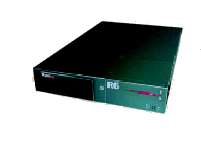|
|
|

|
| Ethernet
Support | SCSI Support | NAS
Engine | Embedded OS | |
|
This
is an example configuration, ideal for desktop storage and scaleable
to mid-level enterprise storage applications including audio,
broadcast, prepress, compact servers, high-speed backup and
data serving. This system was designed to provide a specific
solution to a client requirement. New systems would be conceptually
identical but with the addition of newer revisions of hardware/firmware,
more robust cabinets, and/or additional comms or management
features. Best of breed combinations are always utilised.
|
| |
| From
simple JBOD volumes ready to attach directly to the LAN,
to intelligent independent RAID LAN servers, to hybrid LAN/SAN
servers, we have a NAS solution for every configuration
and requirement. |
| For
a general overview of NAS systems, our technical section
holds some information you may find useful under General
Introduction to NAS |
|
|
|
Example
1
This
type of NAS file server specialises in storing and retrieving
files from an array of disks to which they are connected.
All the software required to run the NAS server resides
in flash memory, rendering these systems entirely self-contained.
This ensures that the server will always boot when there
are no disks attached to it, or in case of a major disk
failure.
Ethernet
Support
Dual 10/100Mb/sec ports for network growth
and load balancing.
SCSI
Support
Systems can be designed to support multiple
Ultra2 LVD SCSI channels, each capable of supporting up
to 15 SCSI devices, thereby consolidating any investment
in existing legacy SCSI hardware. Enclosure may contain
multiple disks which are attached to the first SCSI channel.
External SCSI devices, such as a tape drive or another
enclosure, can be connected to the second SCSI channel.
Disks are organised into volumes to store and retrieve
user data.
Server
Appliance
Example 1: Full featured network file
server with PPC750 processor, 18MB flash memory for OS
and extensions, up to 512MB memory. Obviously a wide range
of systems specifications are available.
Embedded
OS
All NAS devices require an operating system. Some utilise
a Microsoft OS, other use an Open Source OS such as Linux
which can provide afully embedded NAS environment with
upgradeable kernels via web.
Web
Browser Admin
NAS devices are usually installed in minutes using simple
point & click GUI's for setup, monitoring, and administration
purposes.
A
volume is a logical organisation of storage that includes
one or more disks. Example of volume configuration options:
|
- JBOD
(Just a Bunch of Drives - No RAID)
- RAID
Level 0 (Striping without parity)
- RAID
Level 1 (Mirroring)
- RAID
Level 5 (Striping with interdispersed parity)
-
RAID Level 1/0 (Striping with mirroring)
|
 |
|
Each
volume has one file system that organizes user data in
directories and files. Most serious NAS devices support
the NFS and SMB protocols, which enables the exportation
of volumes or individual directories to both Windows and
UNIX clients. To enable other operating systems to use
the server (such as Apple MacOS clients) third-party software
is required that enables them to participate in a SMB
or NFS environment.
|
| |
Example
features of a standard NAS device:
- Browser-based
user interface - allows the system to be administered
from any client with a web browser. The user interface,
or GUI, includes online Help.
- Two
modes of user authentication for MS Networking: Local
or Domain - With local authentication, the server uses
its own user database to authenticate users. With domain
authentication, the server lets a domain controller
authenticate users.
- Assign
multiple hotspare disks - to automatically replace defective
disks in a volume.
- Support
MS Networking (SMB or CIFS protocol): This includes
Windows (3.11, 95, 98, ME, NT 3.51, NT 4, and Windows
2000) and OS/2 Warp 4.
- NFS
Support for UNIX clients with NFS V2 over UDP. This
includes Linux, and Solaris versions 2.5, 2.5.1, 2.6,
and 7.
- Ethernet
ports supporting a combination of 10 Base-T, 100 Base-T,
GigaEthernet connections.
- Multiple
or single internal drive bays.
- Full
or incremental backup policies. Users can also set up
custom backup sets including scheduling.
- Built-in
diagnostics for diagnosing hardware failure.
|
| |
| |
|
| |
|
|
|
|